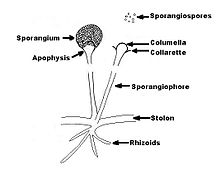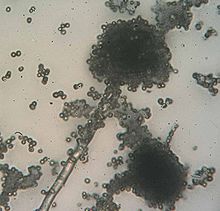Rhizopus
| Rhizopus | |
|---|---|

| |
| Schematic diagram of Rhizopus spp. | |
| Scientific classification | |
| Domain: | Eukaryota |
| Kingdom: | Fungi |
| Division: | Mucoromycota |
| Order: | Mucorales |
| Family: | Mucoraceae |
| Genus: | Rhizopus Ehrenb. (1820)
|
| Type species | |
Rhizopus nigricans Ehrenb. (1820)
| |
| Synonyms[1] | |
| |
Rhizopus is a

Rhizopus species grow as filamentous, branching
- Rhizopus oligosporus is used to make tempeh, a fermented food derived from soybeans.
- Rhizopus oryzae is used in the production of alcoholic beverages in parts of Asia and Africa.
- black bread mold) causes fruit rot on strawberry, tomato, and Sweet potato and is used in commercial production of fumaric acid and cortisone.
Various species, including R. stolonifer, may cause
Rhizopus helps in nutrient development since this species is grown in soil it ferments the fruits and vegetable in the soil inhibiting the growth and develops certain pathogens that inhibits the growth of toxigenic fungus.[5] In addition to that, there is even a type of Rhizopus (Rhizopus microsporus-fermented soybean tempe) that has proven to reduce colon carcinogenesis in rats by elevating factors of mucins, immunoglobulin A, and organic acids and give protection to piglets from Escherichia coli-infection by inhibiting adhesion to the intestinal membranes. [6]
Phylogeny
The mating analysis has also been found which was comparative that this species structure is flexible in comparison with other species in the same genus. The topology length of the species genome is found to be three times bigger with the species.[7]
Species
- Rhizopus americanus
- Rhizopus arrhizus
- Rhizopus azygosporus
- Rhizopus caespitosus
- Rhizopus circinans
- Rhizopus delemari
- Rhizopus homothallicus
- Rhizopus lyococcus
- Rhizopus microsporus
- Rhizopus niveus
- Rhizopus oligosporus
- Rhizopus oryzae
- Rhizopus reflexus
- Rhizopus rhizopodiformis
- Rhizopus schipperae
- Rhizopus sexualis
- Rhizopus stolonifer (black bread mold)
See also
- Black bread mold
- Mucormycosis
References
- ^ "Rhizopus Ehrenb. 1820". MycoBank. International Mycological Association. Retrieved 2011-02-05.
- ISBN 978-0-85199-826-8.
- ^ Zheng RY, Chen GQ, Huang H, Liu XY (2007). "A monograph of Rhizopus". Sydowia. 59 (2): 273–372.
- S2CID 13369408.
- ^ Dwi Endrawati, Dwi Endrawati. "Several Functions of Rhizopus sp on Increasing Nutritional Value of Feed Ingredient". June 2017.
- S2CID 91791814.
- PMID 29674435.
External links
- Rhizopus at Zygomycetes.org
- Photos of Rhizopus spp. used for tempeh-making[permanent dead link] at www.tempeh.idv.tw
